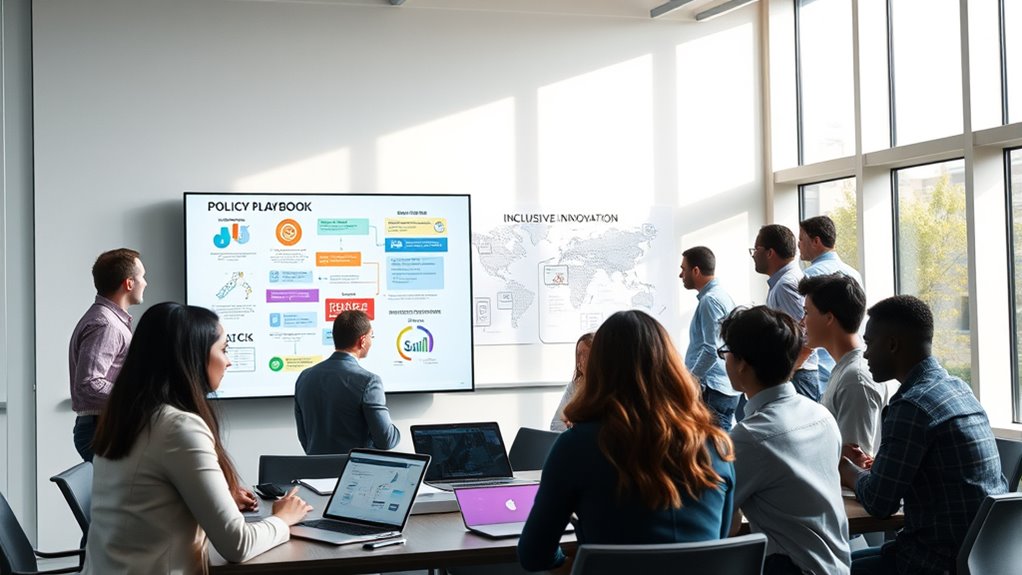To help workers through automation, you should develop policies that promote skill development and lifelong learning, ensuring workers can adapt to new roles. Strengthen safety nets like retraining programs, unemployment insurance, and flexible support systems such as Universal Basic Income. Focus on inclusive AI practices and ethical deployment while fostering innovation that creates new job opportunities. For a holistic approach to supporting workers during this shift, exploring further will provide valuable insights.
Key Takeaways
- Develop inclusive safety nets like retraining programs, unemployment insurance, and social pensions to support displaced workers.
- Promote lifelong learning and continuous upskilling to help workers adapt to technological changes.
- Implement policies addressing vulnerable groups, especially older workers, to ensure fair transition support.
- Encourage industry partnerships and public awareness initiatives to boost digital literacy and skills development.
- Establish responsible AI deployment guidelines and ethical frameworks to protect workers and ensure safe automation.
Understanding the Impact of Automation on Employment

Automation is rapidly transforming employment landscapes worldwide, driven by advances in AI, robotics, and digital technologies. You’ll notice that 86% of employers see AI and information processing as the most transformative forces. By 2030, over half of businesses expect robotics and automation to profoundly impact their operations, especially in energy, where automation will influence around 41%. Many workers have already felt this shift; about 14% have experienced job displacement due to AI. In recent months, AI contributed to 5% of all job losses in the U.S., affecting sectors like tech, customer service, and legal services. Automation boosts productivity and reduces costs but also leads to declines in roles like medical transcriptionists, paralegals, and insurance adjusters. Current impact shows that 14% of workers have experienced job loss due to automation or AI, while others, such as roles in computer technology, will grow, demanding new skills. Additionally, the rise of technological disruption has accelerated the need for workforce retraining and reskilling initiatives to support affected employees. Moreover, the development of AI safety measures is crucial to ensure these technologies are deployed responsibly and securely. Recognizing the importance of ethical AI practices can help guide the responsible integration of automation into society. As the vetted solutions for worker protection and adaptation evolve, ongoing policy updates will be essential to mitigate negative impacts. For example, understanding the impact of job displacement can help shape effective policy responses and support systems.
Developing Skills for the Future Workforce

To prepare for the future workforce, you need to focus on building digital skills that are increasingly in demand. Implementing effective reskilling and upskilling strategies guarantees workers stay relevant as technology evolves. By prioritizing continuous learning, you can help your workforce adapt quickly and seize emerging opportunities. Impact of Automation and AI on Skill Demands is expected to accelerate skill shifts, emphasizing the importance of proactive skill development programs. Incorporating well-being tips into training initiatives can also enhance employee resilience and productivity during these transitions. Recognizing the importance of essential oils for stress relief can further support workers’ mental health as they navigate these changes.
Digital Skills Development
How can organizations guarantee their workforce is prepared for rapid technological changes? The key is investing in digital skills development now. With 90% of companies undergoing digital transformation, staying current is essential. The demand for AI skills, especially generative AI, is surging, and 81% of organizations face skills shortages. A significant portion of workers, like 27% in the UK, lack the digital skills needed for their roles, affecting performance. By fostering continuous learning and offering targeted training, you can bridge these gaps. The evolution of digital skills has transitioned from basic computer literacy to advanced tech competencies essential for nearly all jobs. Additionally, understanding personal development techniques can help tailor training programs to meet industry needs more effectively. Developing digital literacy is fundamental in ensuring employees can adapt to new tools and workflows. Cultivating emotional bonds and developing soft skills are also crucial in adapting to new digital workflows. Digital skills not only improve workplace efficiency but also open pathways for career growth. As automation and AI reshape industries, equipping your workforce with essential digital competencies ensures your organization remains competitive and resilient in the future economy.
Reskilling and Upskilling Strategies
Developing skills for the future workforce requires proactive reskilling and upskilling strategies that keep pace with rapid technological change. With 14% of jobs predicted to be eliminated and 32% transformed in the next 15–20 years, you need to adapt quickly. Over half of employees required significant upskilling by 2022, driven by digitalization, and automation could impact half of global work activities. To stay relevant, you must focus on lifelong learning, industry partnerships, and continuous training. Companies like Amazon and AT&T invest heavily in retraining programs for roles in AI, data analytics, and cloud computing. Emphasizing digital literacy, adaptability, and emerging skills helps you remain competitive, reduces displacement risks, and supports smoother career transitions in an evolving job landscape. Recent forecasts also highlight that over 1 billion people worldwide could be affected by these changes, underscoring the urgency of proactive workforce development. Additionally, understanding the impact of automation on specific industries can help tailor effective reskilling initiatives. Incorporating natural environment considerations into training programs can promote sustainable practices as technology advances. Recognizing the importance of software quality assurance techniques and tools can further enhance the skill set required for future-proof careers. Moreover, embracing remote hackathons can foster innovation and collaboration among geographically dispersed teams, accelerating skill development and problem-solving capabilities. Staying updated on the latest in technology trends is essential for designing relevant training programs that meet future workforce needs.
Designing Policies for Worker Protection and Support

Have you considered how policies can better protect and support workers in an era of rapid automation? You need policies that address the risks faced by vulnerable groups, especially older workers, who struggle to adapt to new technologies and face higher job threats. Current frameworks often overlook these needs, leaving many unprotected. To bridge this gap, you should develop inclusive safety nets, such as targeted retraining programs and digital skills initiatives. Strengthening workplace safety measures is vital, especially with AI-powered monitoring and surveillance affecting workers’ health and safety. Policies must promote fair transitions, reduce disparities across job sectors, and guarantee that workers aren’t left behind as automation accelerates. Automation exposure varies within occupations, complicating policy design. Effective protection relies on proactive, adaptable policies that prioritize worker well-being and resilience, including comprehensive support systems that address the diverse impacts of automation. Recognizing the importance of worker vulnerability can help tailor interventions to those most at risk during technological transitions.
Fostering Inclusive Innovation and Responsible AI Adoption

Are you aware of the critical role that inclusive innovation and responsible AI adoption play in shaping equitable economies? AI is transforming sectors like fintech, banking, and software, but access remains limited in developing regions. To bridge this gap, AI can support essential services such as telemedicine and e-learning, especially for underserved populations. However, many regions face barriers like lack of skills, infrastructure, and awareness.
| Challenge | Opportunity |
|---|---|
| Limited access in LICs | AI-powered assistive tech for disabilities |
| Skills gaps | Training programs to boost adoption |
| Data privacy concerns | Ethical frameworks and transparency |
| Scaling AI in businesses | Collaboration and funding support |
Fostering responsible AI ensures fairness, privacy, and inclusion, crucial for sustainable growth.
Creating New Job Opportunities and Economic Growth Strategies

As artificial intelligence and automation reshape industries worldwide, new job opportunities are emerging across sectors like AI, robotics, and renewable energy. You’ll see growth in roles such as Big Data Specialists, Fintech Engineers, and AI Experts—fastest-growing jobs in the market. The creation of these roles could add up to 170 million jobs by 2030, representing about 14% of today’s employment. To capitalize on this, focus on three key strategies:
Emerging roles in AI, robotics, and renewable energy could create 170 million jobs by 2030, transforming the future workforce.
- Invest in emerging sectors like renewable energy and advanced manufacturing.
- Develop innovation hubs to support entrepreneurship and technological breakthroughs.
- Implement education and training programs to equip workers with skills for new roles. Broadening digital access is projected to be the most transformative trend, impacting industries and employment opportunities globally. These strategies foster economic growth while helping workers shift into the jobs of the future.
Building Resilient and Adaptive Social Safety Nets

To build resilient and adaptive social safety nets, you need to focus on strengthening support systems that can respond to changing economic conditions. Promoting lifelong learning initiatives helps workers stay relevant as automation transforms industries. By integrating these strategies, you can create safety nets that are both flexible and sustainable, ensuring everyone remains protected.
Strengthening Social Support Systems
How can social safety nets become more resilient and adaptable in the face of rapid technological change? You need to expand coverage, enhance flexibility, and connect support with workforce development. Here are key steps:
- Broaden participation so more workers, especially those displaced by automation, access benefits like unemployment insurance and social pensions.
- Introduce flexible programs like Universal Basic Income (UBI) that provide unconditional support during economic shifts.
- Integrate safety nets with training initiatives, enabling workers to acquire new skills and transition smoothly into emerging industries.
Promoting Lifelong Learning Initiatives
Building resilient social safety nets requires more than just broadening coverage and ensuring flexibility; it depends on fostering a culture of lifelong learning. As automation and AI transform jobs, you’ll need to continuously upgrade your skills to stay relevant. Countries with strong adult learning systems see higher employment and productivity, demonstrating the value of ongoing education. Investing in upskilling and reskilling boosts productivity, helps workers adapt to automation, and preserves job relevance. Employers that prioritize employee development retain talent and gain competitive advantages. Governments should support policies that promote continuous learning, update education systems, and foster industry partnerships. Raising public awareness about lifelong learning’s importance encourages participation. The success of these initiatives is reflected in higher employment rates, increased productivity, and better adaptation to technological changes.
Frequently Asked Questions
How Can Small Businesses Effectively Implement Automation Without Risking Layoffs?
To implement automation without risking layoffs, focus on augmenting your employees’ roles rather than replacing them. Identify tasks that can be automated to boost productivity and create new opportunities. Involve your team in selecting and testing automation tools, offer training, and communicate clearly about how automation supports growth. By gradually integrating automation and emphasizing upskilling, you help your staff adapt and thrive alongside new technologies.
What Role Do Public-Private Partnerships Play in Workforce Transition Strategies?
Public-private partnerships are essential in workforce shift strategies because they combine resources and expertise from both sectors. You can leverage these partnerships to develop tailored training programs, create sustainable talent pipelines, and address skills gaps. They foster collaboration, ensuring training aligns with employer needs. By doing so, you help workers transition smoothly to new roles, boost employability, and support economic mobility, especially in regions impacted by automation and digital transformation.
How Can Lifelong Learning Be Incentivized Across Different Socioeconomic Groups?
You might think lifelong learning benefits everyone equally, but that’s not always true. To truly incentivize learning across socioeconomic groups, you need targeted support like financial aid, accessible online resources, and community-based programs. By making education affordable and reachable, you encourage everyone to upskill. When you invest in outreach and flexible learning options, you create an environment where all workers are motivated and able to adapt to automation’s challenges.
What Measures Ensure Ethical AI Deployment in Sensitive Industries Like Healthcare?
To guarantee ethical AI deployment in healthcare, you should establish clear ethical frameworks that address potential dilemmas, such as dehumanization and bias. Implement transparency measures like explainable algorithms and regular audits to hold systems accountable. Engage stakeholders—patients, providers, and communities—to build trust, and enforce strong regulatory oversight. Consistently monitor AI performance and update practices to adapt to new risks, ensuring responsible and fair use of AI in sensitive healthcare settings.
How Will Automation Influence Global Economic Inequalities and Developing Nations?
Automation will widen global economic inequalities by benefiting developed nations and capital owners, leaving developing countries behind. You might see increased job displacement for less-educated workers and greater income gaps within and between countries. To address this, you should focus on investing in education, infrastructure, and social safety nets in developing nations. International cooperation is vital to guarantee technology benefits everyone, reducing disparities and fostering inclusive growth worldwide.
Conclusion
As you navigate the automation age, remember that embracing continuous learning isn’t just smart—it’s essential. History shows that technological shifts often create new opportunities when people adapt. By proactively developing skills and supporting inclusive policies, you can help guarantee a resilient workforce. So, don’t wait for change to happen; take action now. After all, when you invest in your adaptability, you’re shaping a future where technology and workers thrive together.









